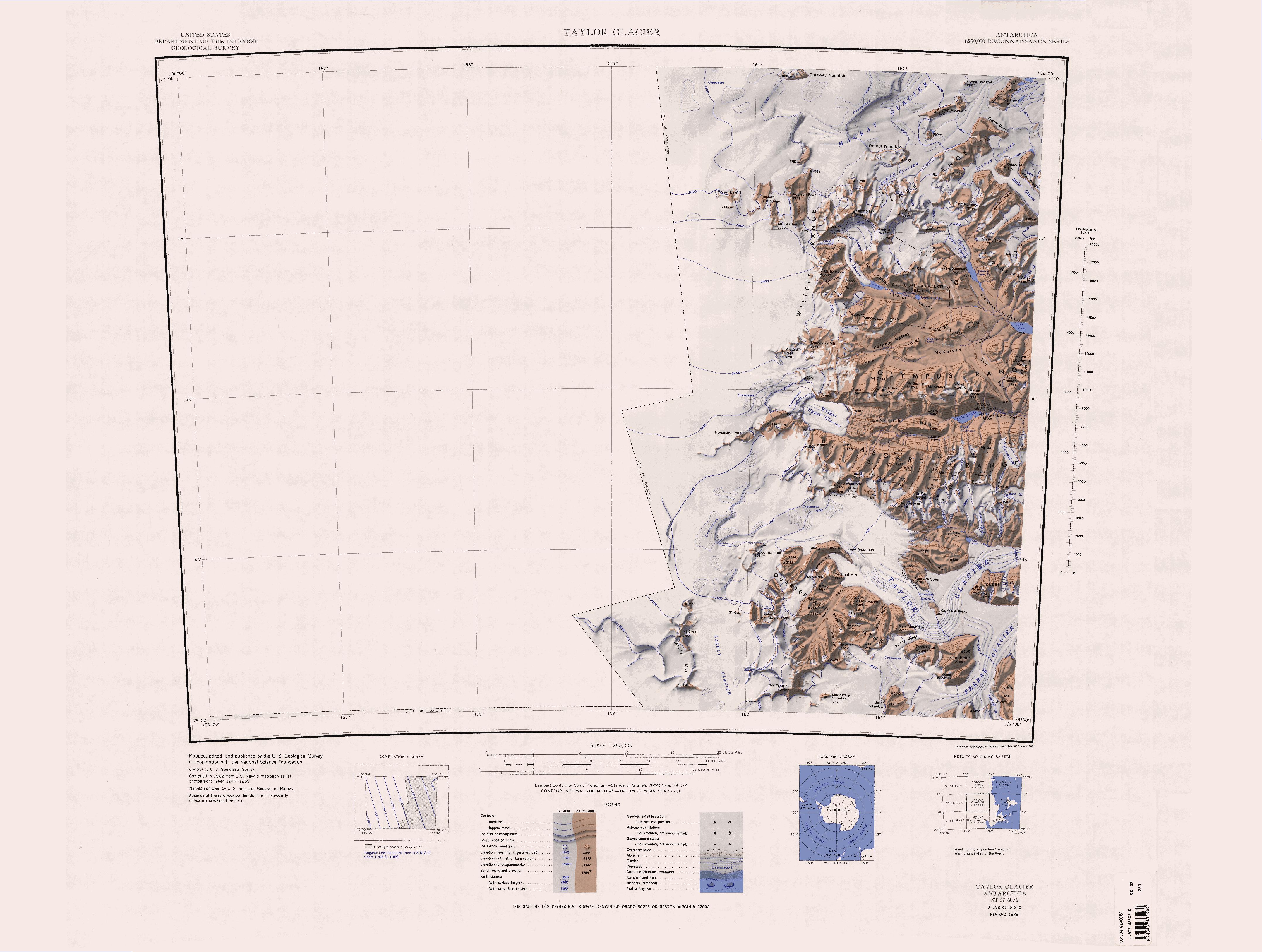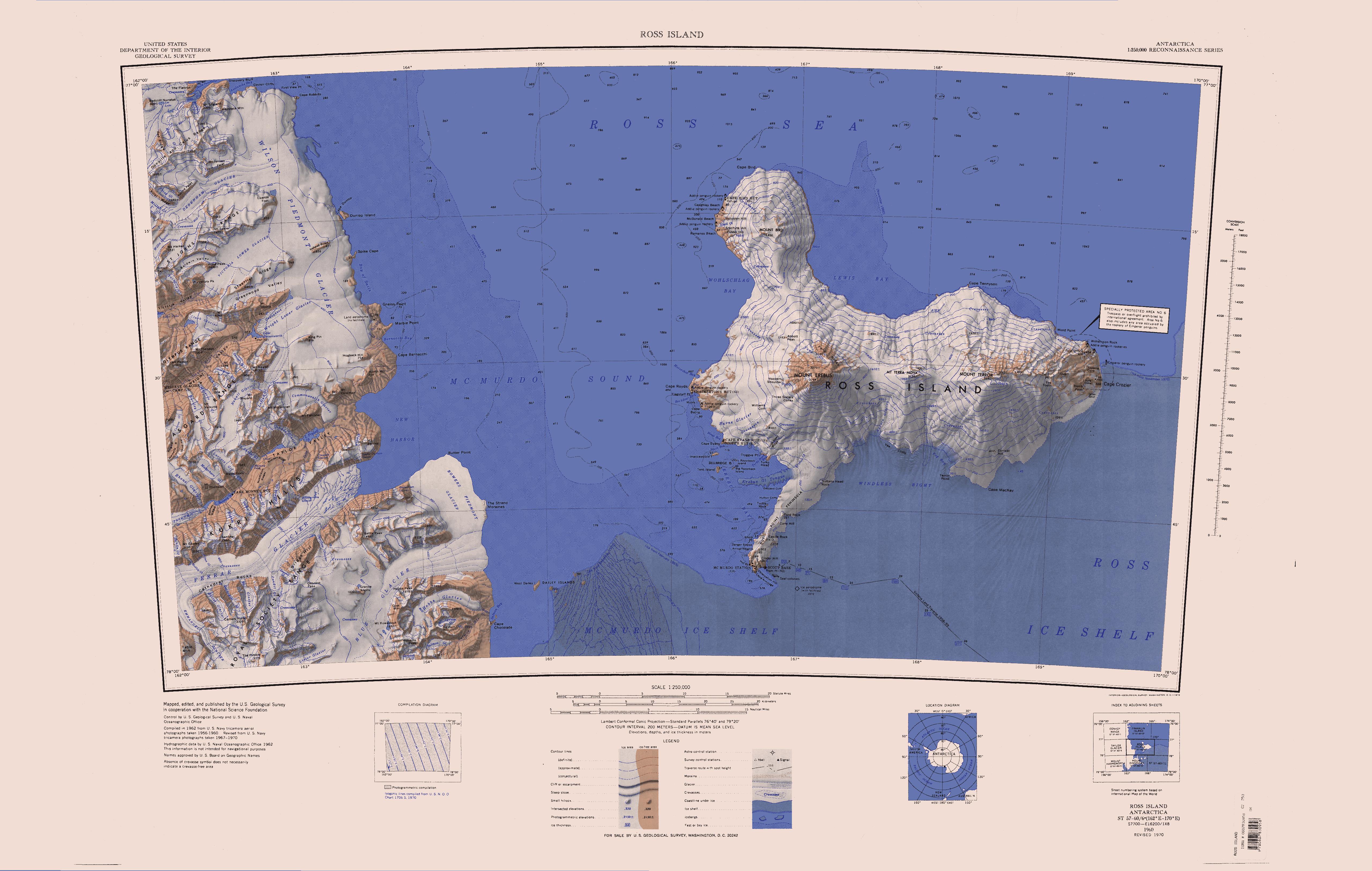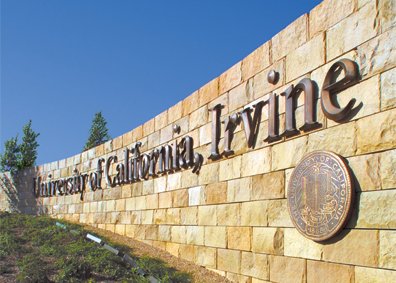|
Saint Johns Range
Saint Johns Range () is a crescent-shaped mountain range about long, in Victoria Land, Antarctica. It is bounded on the north by the Cotton Glacier, Miller Glacier and Debenham Glacier, and on the south by Victoria Valley and the Victoria Upper Glacier and Victoria Lower Glacier. Name Saint Johns Range was named by the New Zealand Northern Survey Party of the Commonwealth Trans-Antarctic Expedition (CTAE), 1956–58, which surveyed peaks in the range in 1957. Named for St John's College, Cambridge, England, with which several members of the British Antarctic Expedition, 1910–13 were associated during the writing of their scientific reports, and in association with the adjacent Gonville and Caius Range. Location Saint Johns Range is bounded to the west by the Victoria Upper Glacier and the Victoria Valley, which runs in a south-southeast direction to Lake Vida. Below Lake Vida the Victoria Valley turns to an east-northeast direction. It is filled by the Victoria Lower Glacier ... [...More Info...] [...Related Items...] OR: [Wikipedia] [Google] [Baidu] |
Antarctica
Antarctica () is Earth's southernmost and least-populated continent. Situated almost entirely south of the Antarctic Circle and surrounded by the Southern Ocean (also known as the Antarctic Ocean), it contains the geographic South Pole. Antarctica is the fifth-largest continent, being about 40% larger than Europe, and has an area of . Most of Antarctica is covered by the Antarctic ice sheet, with an average thickness of . Antarctica is, on average, the coldest, driest, and windiest of the continents, and it has the highest average elevation. It is mainly a polar desert, with annual Climate of Antarctica#Precipitation, precipitation of over along the coast and far less inland. About 70% of the world's freshwater reserves are frozen in Antarctica, which, if melted, would raise global sea levels by almost . Antarctica holds the record for the Lowest temperature recorded on Earth, lowest measured temperature on Earth, . The coastal regions can reach temperatures over in the ... [...More Info...] [...Related Items...] OR: [Wikipedia] [Google] [Baidu] |
Olympus Range
The Olympus Range () is a primarily ice-free mountain range of Victoria Land, Antarctica, with peaks over high, between Victoria Valley and McKelvey Valley on the north and Wright Valley on the south. It is south of the Clare Range and north of the Asgard Range. Exploration and naming The Olympus Range was mapped by the Victoria University of Wellington Antarctic Expedition, 1958–59, and named for the Mount Olympus, mythological home of the Greek gods. Peaks in the range are named for figures in Greek mythology. Location The Olympus Range extends from the Antarctic Plateau to the Wilson Piedmont Glacier on the west coast of the Ross Sea. The range is bounded by the Balham Valley, McKelvey Valley and Victoria Valley to the north, and the Wright Valley to the south. Glaciers Glaciers and snowfields include, from west to east, Nakai Snowfield, Orestes Glacier, Cerberus Glacier, Sandy Glacier, Enyo Glacier, Clio Glacier, Eos Glacier, Chinn Glacier and Clark Glacier ... [...More Info...] [...Related Items...] OR: [Wikipedia] [Google] [Baidu] |
Nobel Prize In Chemistry
The Nobel Prize in Chemistry () is awarded annually by the Royal Swedish Academy of Sciences to scientists in the various fields of chemistry. It is one of the five Nobel Prizes established by the will of Alfred Nobel in 1895, awarded for outstanding contributions in chemistry, physics, literature, peace, and physiology or medicine. This award is administered by the Nobel Foundation and awarded by the Royal Swedish Academy of Sciences on proposal of the Nobel Committee for Chemistry, which consists of five members elected by the Academy. The award is presented in Stockholm at an annual ceremony on December 10th, the anniversary of Nobel's death. The first Nobel Prize in Chemistry was awarded in 1901 to Jacobus Henricus van 't Hoff, of the Netherlands, "for his discovery of the laws of chemical dynamics and osmotic pressure in solutions". From 1901 to 2024, the award has been bestowed on a total of 195 individuals. The 2024 Nobel Prize in Chemistry was awarded to Demis Hassabis ... [...More Info...] [...Related Items...] OR: [Wikipedia] [Google] [Baidu] |
University Of California At Irvine
The University of California, Irvine (UCI or UC Irvine) is a public land-grant research university in Irvine, California, United States. One of the ten campuses of the University of California system, UCI offers 87 undergraduate degrees and 129 graduate and professional degrees, and roughly 30,000 undergraduates and 7,000 graduate students were enrolled at UCI as of Fall 2024. The university is classified among "R1: Doctoral Universities – Very high research activity" and had $609.6 million in research and development expenditures in 2023, ranking it 56th nationally. UCI became a member of the Association of American Universities in 1996. The university administers the UC Irvine Medical Center, a large teaching hospital in Orange, and its affiliated health sciences system; the University of California, Irvine, Arboretum; and a portion of the University of California Natural Reserve System. UC Irvine set up the first Earth System Science Department in the United States. The ... [...More Info...] [...Related Items...] OR: [Wikipedia] [Google] [Baidu] |
Ernest Rutherford
Ernest Rutherford, 1st Baron Rutherford of Nelson (30 August 1871 – 19 October 1937) was a New Zealand physicist who was a pioneering researcher in both Atomic physics, atomic and nuclear physics. He has been described as "the father of nuclear physics", and "the greatest experimental physics, experimentalist since Michael Faraday". In 1908, he was awarded the Nobel Prize in Chemistry "for his investigations into the disintegration of the elements, and the chemistry of radioactive substances." He was the first Oceanian Nobel laureate, and the first to perform the awarded work in Canada. Rutherford's discoveries include the concept of radioactive half-life, the radioactive element radon, and the differentiation and naming of Alpha decay, alpha and Beta particle, beta radiation. Together with Thomas Royds, Rutherford is credited with proving that alpha radiation is composed of helium nuclei. In 1911, he theorized that atoms have their charge concentrated in a very small atomi ... [...More Info...] [...Related Items...] OR: [Wikipedia] [Google] [Baidu] |
Victoria University Of Wellington Antarctic Expedition
The Antarctic Research Centre (ARC) is part of the School of Geography, Environment and Earth Sciences at Victoria University of Wellington. Its mission is to research " Antarctic climate history and processes, and their influence on the global climate system. The current director of the Antarctic Research Centre is Associate Professor Robert McKay. Directors * 1972–2007: Professor Peter Barrett * 2008–2016: Professor Tim Naish * 2017–2019: Professor Andrew Mackintosh * 2020–present: Professor Robert McKay History In December 1957, geology students Barrie McKelvey and Peter Webb along with biologist Ron Balham conducted an expedition to the then unexplored McMurdo Dry Valleys via the Royal New Zealand Navy Antarctic support ship HMNZS ''Endeavour''. This expedition formed the basic for the annual Victoria University of Wellington Antarctic Expeditions, which continue to the present day. Since this first expedition, over 400 staff and students have travelled to t ... [...More Info...] [...Related Items...] OR: [Wikipedia] [Google] [Baidu] |
Thomas Griffith Taylor
Thomas Griffith "Grif" Taylor (1 December 1880 – 5 November 1963) was an English-born geographer, anthropologist and world explorer. He was a survivor of Captain Robert Scott's Terra Nova Expedition to Antarctica (1910–1913). Taylor was a senior academic geographer at universities in Sydney, Chicago, and Toronto. Early life Taylor was born in the town of Walthamstow, England, to parents James Taylor, a metallurgical chemist, and Lily Agnes, née Griffiths. Within a year after his birth, the family had moved to Serbia where his father was manager of a copper mine. Three years later, they returned to Britain when his father became director of analytical chemistry for a major steelworks company. In 1893, the family emigrated to New South Wales Australia, where James secured a position as a government metallurgist. Taylor, age 13, attended The King's School in Sydney. He enrolled in arts at the University of Sydney in 1899, later transferring to science, attaining his Bachel ... [...More Info...] [...Related Items...] OR: [Wikipedia] [Google] [Baidu] |
Hott Peak
The Helicopter Mountains () are a series of rugged mountains west of Mount Mahony in the Saint Johns Range, Antarctica. They rise to at Mount James and include also from west to east Touchstone Crag, Mick Peak and Hott Peak. The mountains form the northwest end of the Saint Johns Range. Name The Helicopter Mountains were so named by the Advisory Committee on Antarctic Names in 2007 in recognition of the wide use of helicopters in supporting the U.S. Antarctic Program at McMurdo Sound and the McMurdo Dry Valleys. Peaks in the mountains have been named after personnel in the helicopter group. Features Touchstone Crag . A rugged mountain high, west of Mick Peak in the west part of Helicopter Mountains. The abrupt south-facing cliffs of the feature also mark the northwest extremity of Saint Johns Range. Named by US-ACAN (2007) after Steven Touchstone, helicopter mechanic in support of the United States Antarctic Program at McMurdo Sound and McMurdo Dry Valleys The Mc ... [...More Info...] [...Related Items...] OR: [Wikipedia] [Google] [Baidu] |
Mount James
Mount James () is located in the Lewis Range, Glacier National Park in the U.S. state of Montana. Mount James is northeast of Triple Divide Peak. The Blackfeet name for the mountain is Ah'-kow-to-mak-an (Double Runner). Geology Like the mountains in Glacier National Park, Mt. James is composed of sedimentary rock laid down during the Precambrian to Jurassic periods. Formed in shallow seas, this sedimentary rock was initially uplifted beginning 170 million years ago when the Lewis Overthrust fault pushed an enormous slab of precambrian rocks thick, wide and long over younger rock of the cretaceous period. The route to climb to the top of the mountain is about 9 miles, and the mountain's latitude and longitude are 48.58442°N and -113.49233°W, or 48° 35' 4" north and 113° 29' 32" west. The average barometric pressure of the mountain is about 71KPa. There are also a variety of lakes and peaks surrounding the mountain as well, such as the Medicine Grizzly Lake, the Atl ... [...More Info...] [...Related Items...] OR: [Wikipedia] [Google] [Baidu] |
New Zealand Geographic Board
The New Zealand Geographic Board Ngā Pou Taunaha o Aotearoa (NZGB) is the authority over geographical and hydrographic names within New Zealand and its territorial waters. This includes the naming of small urban settlements, localities, mountains, lakes, rivers, waterfalls, harbours and natural features and may include researching local Māori names. It has named many geographical features in the Ross Sea region of Antarctica. It has no authority to alter street names (a local body responsibility) or the name of any country. The board was established by the New Zealand Geographic Board Act 1946, which has since been replaced by the New Zealand Geographic Board (Ngā Pou Taunaha o Aotearoa) Act 2008. Although an independent institution, it is responsible to the Minister for Land Information. The NZGB secretariat is part of Toitū Te Whenua Land Information New Zealand (LINZ) and provides the board with administrative and research assistance and advice. The New Zealand Geogra ... [...More Info...] [...Related Items...] OR: [Wikipedia] [Google] [Baidu] |





